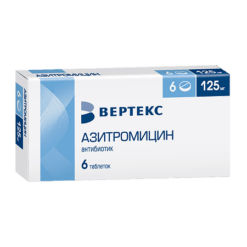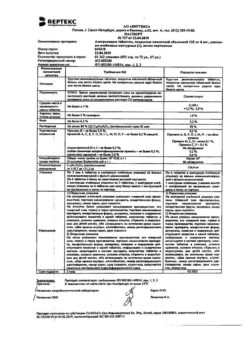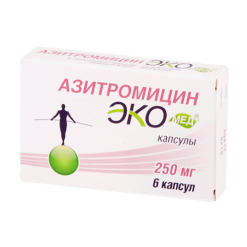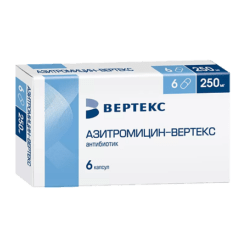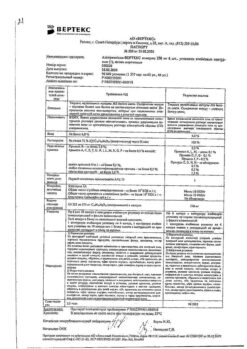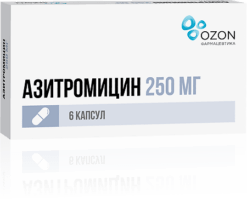No products in the cart.
Azithromycin, 500 mg 3 pcs
€1.00
Out of stock
(E-mail when Stock is available)
Description
Azithromycin is a bacteriostatic broad-spectrum antibiotic of the macrolide-azalid group. It has a wide range of antimicrobial action. The mechanism of action of azithromycin is associated with inhibition of microbial cell protein synthesis. Binding to 50S-subunit of bacterial ribosomes, it inhibits peptidtranslokase at the translation stage and inhibits protein synthesis, slowing down the growth and reproduction of bacteria. In high concentrations it has a bactericidal effect.
It is active against a number of Gram-positive, Gram-negative, anaerobic, intracellular and other microorganisms.
Microorganisms can be initially resistant to the antibiotic or can acquire resistance to it.
Sensitivity scale of microorganisms to azithromycin (Minimum inhibitory concentration (MIC), mg/L)
In most cases sensitive microorganisms:
1. Gram-positive aerobes Staphylococcus aureus (methicillin-sensitive strains)
Streptococcus pneumoniae (penicillin-sensitive strains)
Streptococcus pyogenes
2. Gram-negative aerobes
Haemophilus influenzae
Haemophilus parainfluenzae
Legionella pneumophila
Moraxella catarrhalis
Pasteurella multocida
Neisseria gonorrhoeae
3. Anaerobes
Clostridium perfringens
Fusobacterium spp.
Prevotella spp.
Porphyromonas spp.
4. Other microorganisms
Chlamydia trachomatis
Chlamydia pneumonia
Chlamydia psittaci
Mycoplasma pneumoniae
Mycoplasma hominisBorrelia burgdorferi
Microorganisms that can develop resistance to azithromycin: Gram-positive aerobes
Streptococcus pneumoniae (penicillin-resistant strains)
Initially resistant microorganisms:
Gram-positive aerobes
Enterococcus faecalis
Staphylococcus spp. (methicillin-resistant strains of Staphylococcus spp. have a very high frequency of acquired resistance to macrolides)
Gram-positive bacteria resistant to erythromycin.
Anaerobes
Nasteroides fragilis.
Pharmacokinetics
Absorption: After oral administration azithromycin is well absorbed and quickly distribute in body.
After single administration in dose of 500 mg bioavailability is 37 % (due to “first pass” effect through liver). Maximal concentration (0.4 mg/l) in blood is formed after 2-3 hours.
Distribution: Apparent volume of distribution is 31,1 l/kg, protein binding is inversely proportional to the concentration in blood and is 7-50 %. It penetrates through cell membranes (effective in infections caused by intracellular pathogens). It is transported by phagocytes to the site of infection, where it is released in the presence of bacteria. Easily penetrates the histohaematic
barriers and enters the tissues. Concentration of azithromycin in tissues and cells is 10-50 times higher than in blood plasma, and in foci of infection – 24-34% higher than in healthy tissues.
Metabolism: Azithromycin is demethylated in liver, losing activity.
Excretion: Azithromycin has a very long half-life – 35-50 hours. Tissue elimination half-life is much longer. The therapeutic concentration of azithromycin is maintained up to 5-7 days after the last dose. Azithromycin is mainly excreted unchanged – 50% via the intestine, 6% by the kidneys.
Indications
Indications
Active ingredient
Active ingredient
Composition
Composition
How to take, the dosage
How to take, the dosage
Interaction
Interaction
Special Instructions
Special Instructions
Contraindications
Contraindications
Side effects
Side effects
Overdose
Overdose
Pregnancy use
Pregnancy use
Similarities
Similarities
Additional information
| Shelf life | 2 years. Do not use the drug after the expiration date. |
|---|---|
| Conditions of storage | In the dark place at a temperature not exceeding 25 ° C. Keep out of reach of children. |
| Manufacturer | Biokhimik JSC, Russia |
| Medication form | pills |
| Brand | Biokhimik JSC |
Other forms…
Related products
Buy Azithromycin, 500 mg 3 pcs with delivery to USA, UK, Europe and over 120 other countries.


